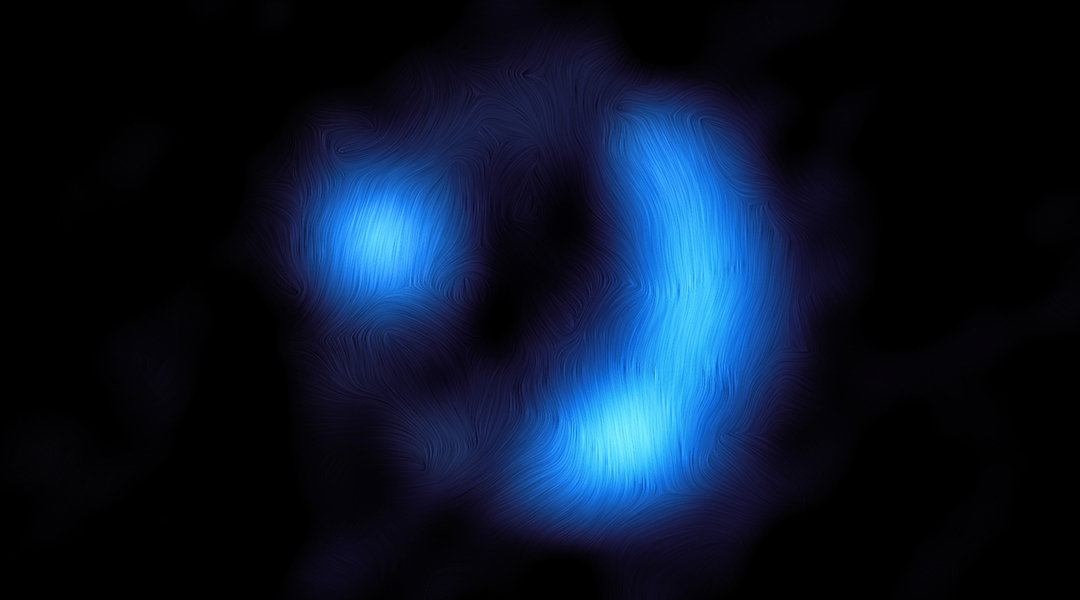Magnetic fields are ubiquitous in the Universe, with stars and planets wrapped in magnetic bubbles. The magnetic shell of our own planet, the magnetosphere, protects Earth’s atmosphere from being stripped by charged particles from the Sun, thus making it vital to the existence of life.
What is less well-known, however, is that entire galaxies, including our own Milky Way, are also laced with magnetic fields. The early origins of these galactic magnetic fields, which can span tens of thousands of light years, are currently not well understood. But because these magnetic fields play a role in the evolution of galaxies, this is a pressing cosmic puzzle.
A team of astronomers led by University of Hertfordshire astrophysicist James Geach have made observations that could help unravel this mystery. They spotted a magnetic field from a galaxy that is seen as it was when our now 13.8 billion-year-old Universe was just 2.5 billion years old; around 20% of its current age.
Galactic magnetic fields
The galactic magnetic field is both the furthest and the earliest ever observed and could give scientists important clues about how galaxies come to be wrapped in magnetic cocoons. The team’s findings are reported in a paper published in the journal Nature.
“This discovery gives us new clues as to how galactic-scale magnetic fields are formed,” Geach explained in a press release from the European Southern Observatory (ESO).
Despite existing in the early Universe, the magnetic field around the galaxy 9io9 is fully formed and spans an incredible 16,000 light-years. Yet despite its impressive size, the magnetic field of 9io9 is around 1,000 times weaker than Earth’s magnetosphere. This finding indicates that galaxy-spanning magnetic fields were present in the Universe as galaxies were still growing.
The team believe that the development of early galactic magnetic fields, like this one, could have been accelerated by a burst of intense star formation. Once developed, the galactic magnetic fields then influence the birth of the next generation of stars and through this, further galaxy growth.
A little help from Einstein
Geach and the team made observations of the magnetic field associated with the galaxy 9io9 with the ESO-operated Atacama Large Millimeter/submillimeter Array (ALMA).
A signal indicating the magnetic field was visible in light that has been travelling to Earth for around 11 billion years thanks to dust grains within 9io9. Dust grains in galaxies weakly align with that galaxy’s magnetic field, and as a result, they emit light waves that oscillate along a preferred direction rather than randomly — so-called polarized light. ALMA spotted this polarisation signal from 9io9, which allowed Geach and colleagues to work out the orientation of the galaxy’s magnetic field.
This is an even more impressive achievement when considering that the polarised light signal emitted by the magnetically aligned dust in 9io9 was extremely faint, representing just 1% of the total brightness of the galaxy. The team was able to amplify the light signal using a phenomenon called “gravitational lensing”.
First predicted by Einstein in his 1915 theory of general relativity, gravitational lensing occurs when light from a distant source passes through spacetime curved by the presence of a large concentration of mass, such as a galaxy.
This distorts the light from this distant source, in this case the galaxy 9io9, which can lead to the brightening of this light and it being amplified like it is passing through a cosmic magnifying glass, hence why the intervening object is called a “gravitational lens.”
Even with the use of this gravitational phenomenon, Geach is clear that ALMA was absolutely integral to this observation. “No other telescope could have achieved this,” the researcher concluded.
Reference: J.E. Geach, et al., Polarized thermal emission from dust in a galaxy at redshift 2.6, Nature (2023). DOI: 10.1038/s41586-023-06346-4
Feature image: This image shows the orientation of the magnetic field in the distant 9io9 galaxy, seen here when the Universe was only 20% of its current age — the furthest ever detection of a galaxy’s magnetic field. Credit: ALMA (ESO/NAOJ/NRAO)/J. Geach et al.

















